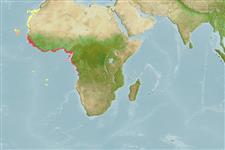Classification / Names
Common names from other countries
Main reference
Size / Weight / Age
Max length : 45.0 cm TL male/unsexed; (Ref. 1380); common length : 30.0 cm TL male/unsexed; (Ref. 3609); max. published weight: 750.00 g (Ref. 4883)
Environment
Marine; brackish; benthopelagic; depth range 10 - 75 m (Ref. 27000), usually 20 - 50 m (Ref. 81287)
Climate / Range
Tropical, preferred 27°C (Ref. 107945); 30°N - 17°S, 27°W - 13°E
Distribution
Short description
Dorsal
spines
(total): 8 - 9;
Dorsal
soft rays
(total): 17-18;
Anal
spines: 3;
Anal
soft rays: 20 - 21. Diagnosis: body deep and strongly compressed, its anterior profile very steep up to dorsal-fin origin, and strongly compressed; head small; snout short; mouth small, terminal, strongly protrusible, with fleshy lips; teeth slender and pointed, set in bands in upper jaw; roof of mouth toothless; dorsal fin deeply notched; 1st dorsal fin spine small, forward-pointing and visible only in young individuals; pectorals falcate, very long, their tips almost reaching to caudal-fin base; hind margin of caudal fin slightly rounded; pelvic fins thoracic; scales finely ctenoid, covering body, bases of dorsal and anal fins and head, except snout and preopercle; preopercular margin denticulate; lateral line strongly arched (Ref. 81287).
Coloration: silvery grey, darker on back, almost white on belly; sides with a series of 8 brown, more or less faded vertical bars, always more distinct in young individuals (Ref. 81287).
IUCN Red List Status (Ref. 115185)
Threat to humans
Harmless
Human uses
Fisheries: minor commercial
More information
Common namesSynonymsMetabolismPredatorsEcotoxicologyReproductionMaturitySpawningFecundityEggsEgg development
ReferencesAquacultureAquaculture profileStrainsGeneticsAllele frequenciesHeritabilityDiseasesProcessingMass conversion
Tools
Special reports
Download XML
Internet sources
Estimates of some properties based on models
Phylogenetic diversity index
PD50 = 0.7500 many relatives (e.g. carps) 0.5 - 2.0 few relatives (e.g. lungfishes)
Trophic Level
3.1 ±0.41 se; Based on food items.
Resilience
Medium, minimum population doubling time 1.4 - 4.4 years (K=0.13-0.25)
Vulnerability
High vulnerability (56 of 100)
Price category
